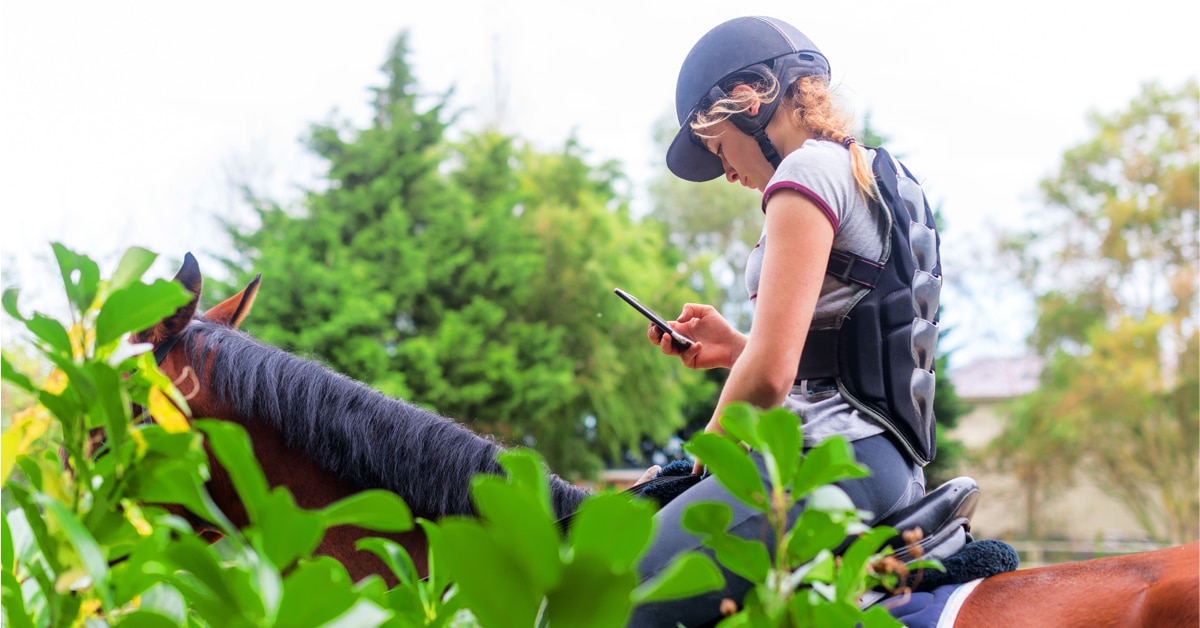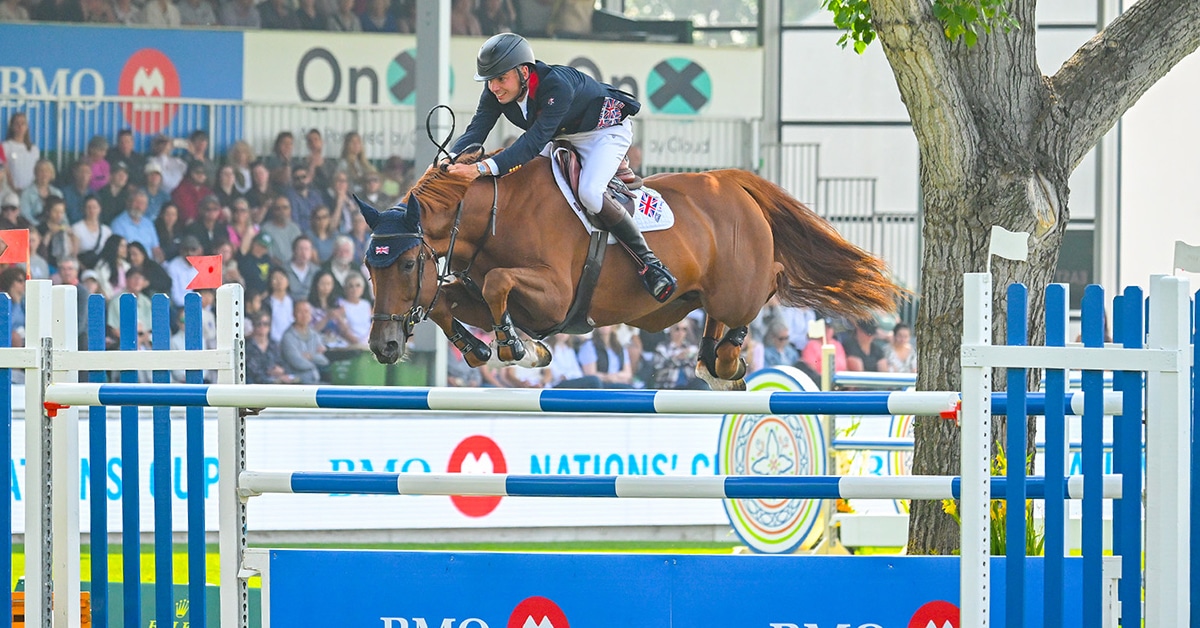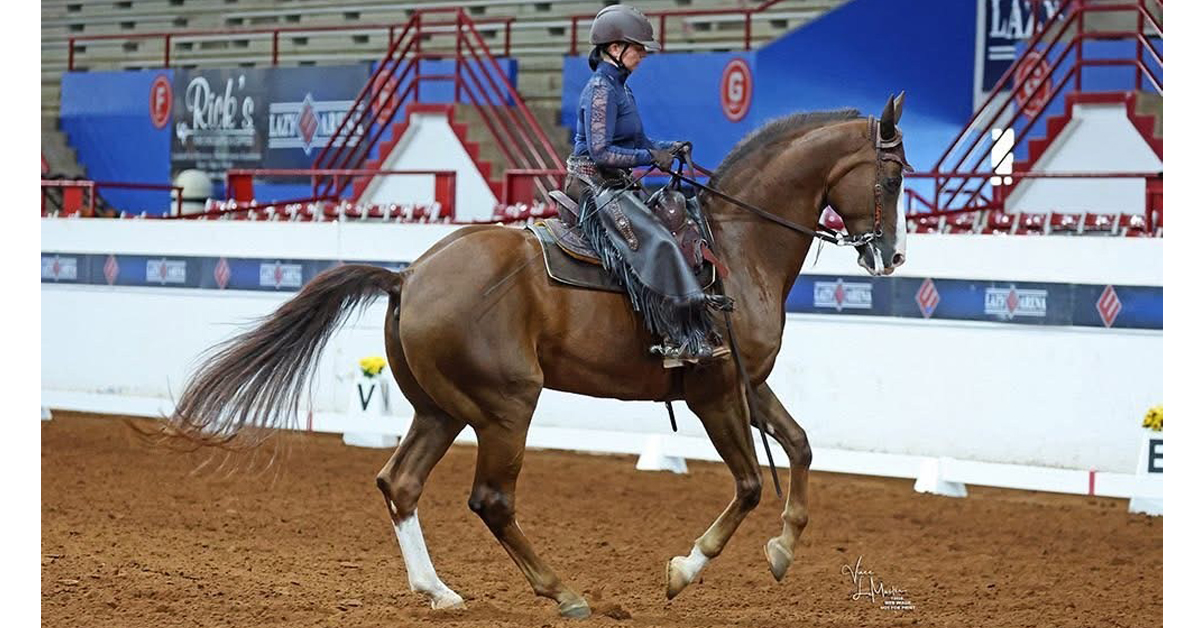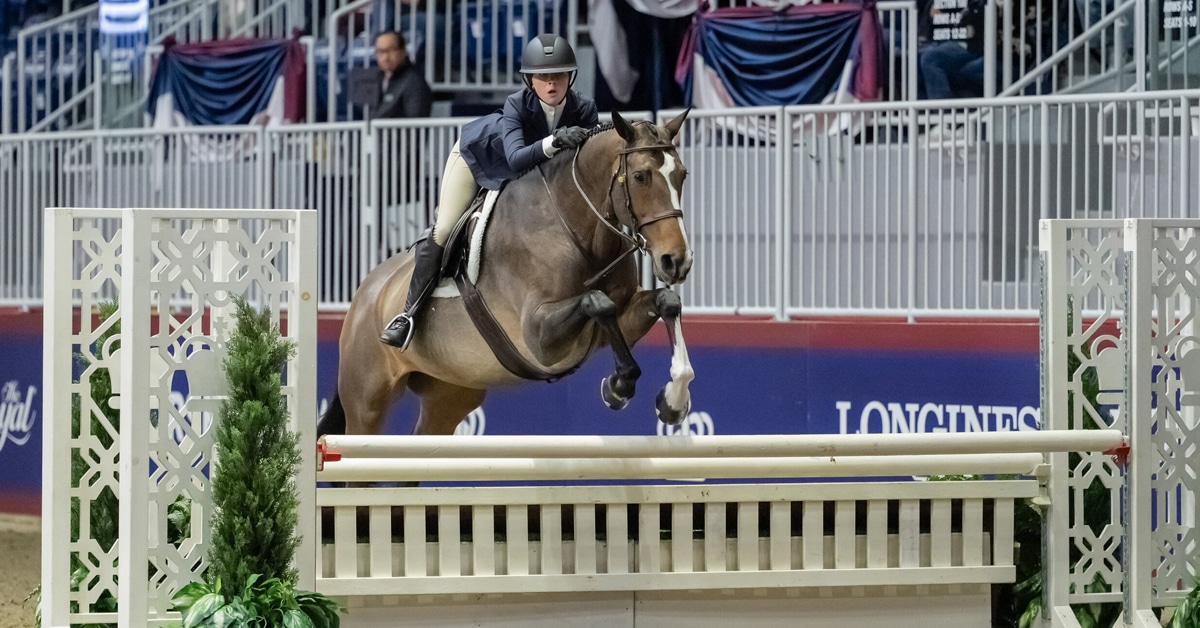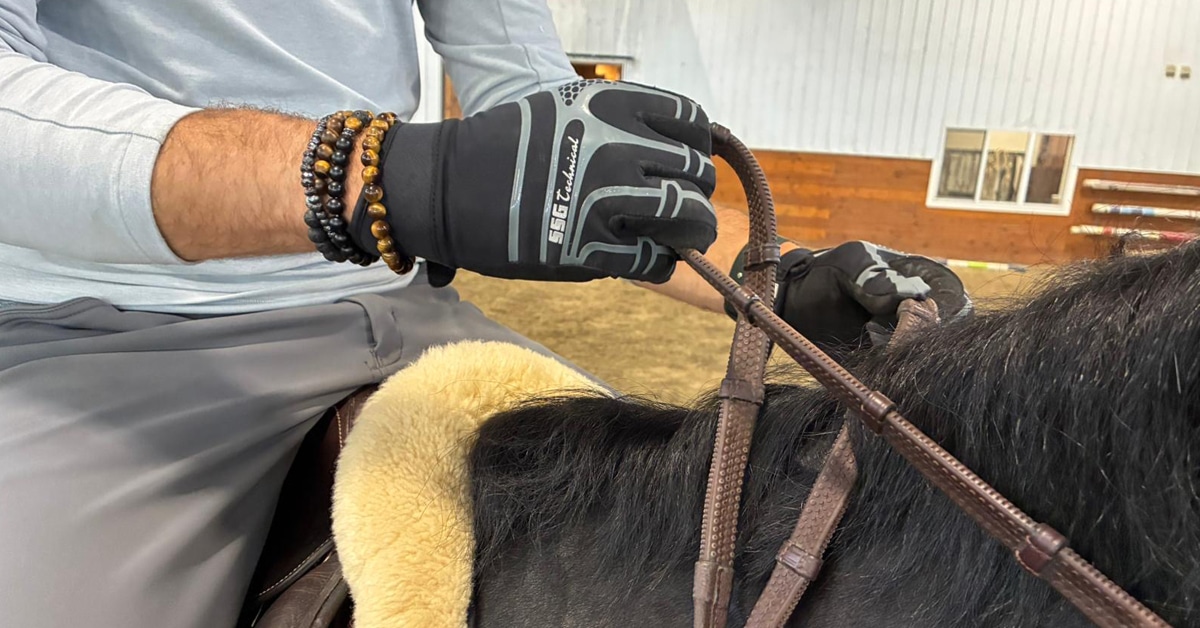As is often the case when we learn and progress in a given field, the more we learn and grow in our riding, the more we discover nuances and sophistication in how we communicate with our horses.
For instance, our rein aids are certainly among the most important and commonly used methods to interact and signal our horses about all kinds of things. While at the beginning of our riding development the reins serve blunt functions – stop and steer – we can fine-tune the rein aids to mean so much more, and importantly we can learn to say more with less. Signaling with our reins can be a delicate and precise action, where even the smallest movement or adjustment can create a big change.
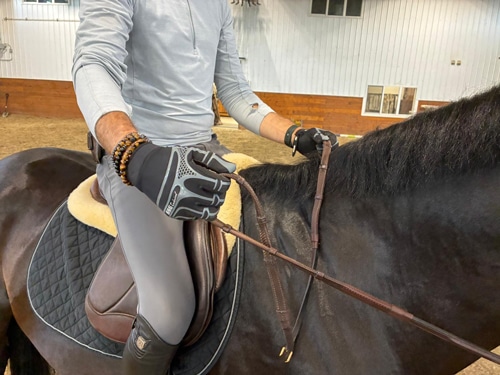
The opening rein. (Holly Grayton photo)
To begin, we should clarify the terminology for the different types of rein aid. While everyone may have their own personal version, it is fair to say that the following terms are relatively ubiquitous, and they will be our focus here: opening rein, direct rein, wide reins, lifted (leveraged) rein, indirect rein, driving rein, and bridged reins.
The most basic and simplest is the opening rein. It is commonly used when starting and riding a young horse to start the conversation about contact and connection, to teach the horse to follow their nose and turn. It is what we use most with young horses because it is the lightest, easiest to understand, and least specific. It is like painting with a very broad brush. It is offering a suggestion – we show the horse a space, encouraging them to fill the space. It allows us as the rider to use our leg to encourage the horse to fill the space created by the opening rein.
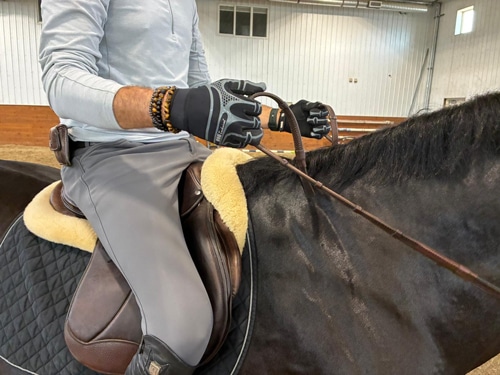
The direct rein. (Holly Grayton photo)
Just because we use it with young horses doesn’t mean it isn’t still very frequently used with upper-level and more highly-trained horses, too. We may want to move a horse’s shoulder on the flat or around a corner, and opening the outside rein is often a handy aid to employ. Over a jump in a jump-off it is the simplest way to indicate an early turn on landing without affecting the jump (because it does not change the amount of contact the horse feels, just creates space). It can also be instrumental in straightness corrections at jumps (off the ground or in the air) for the same reason.
Still very simple but with a change in the amount of contact the horse feels, is the direct rein. As the name implies, the rider pulls in a straight and direct line away from the corners of the mouth, along the line of the rein (keeping the straight line from the rider’s elbow through their hand to the horse’s mouth). This increase in pressure on the horse’s mouth should yield some reaction. The rider’s arm will bend more as a result of applying the rein aid.
There is often only one instruction with this rein and it is to turn the horse’s head, or to slow or stop, depending on if only one rein is being used, or both at once.
The wide rein is essentially when both reins are used as opening reins (as described above) at the same time. A rider might use wide reins to create some stability in the mouth, especially on a young horse, when they don’t yet understand a good contact. Widening both hands will change the effect of the bit in the mouth – if the bit is single-, double-, or multi-jointed, widening the reins will take away some of the effect of the joints, creating more of a straight-bar effect (hence stability).
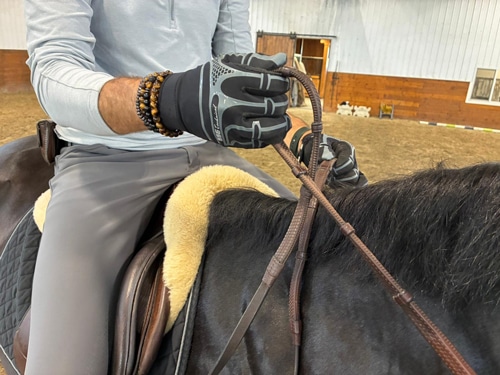
The lifted rein. (Holly Grayton photo)
No matter the mouthpiece, widening the reins can create a sort of funnel for the horse to feed into. The shoulders have freedom to operate laterally with the space created by the opening reins, and with a bit of forward impulsion added the rider can funnel the horse from that wider space towards a more defined target which is the bit (and whatever is in front of that).
Now we enter more complicated territory. The lifted (or leveraged) rein is effectively when the direct rein aid is applied but the rider’s hand is lifted to whatever degree is preferred while pulling. This lift creates a leverage effect, and encourages flexion or rotation at the poll.
As always, there are no hard-and-fast rules about how horses react to any situation – it is truly up to our equine friends to react however they see fit. So while a lifted rein might result in increased flexion at the poll, with all else being equal and controlled, it’s also possible that a horse doesn’t like that pressure and resents it, resulting in simply arguing with that pressure. It is crucial to be empathetic to our horses and try to communicate, not command, as though there are absolutes.
The indirect rein (see photo at top of article) starts like the direct rein, where an increase in pressure is applied on the mouth, but the direction of the pull is towards the riders opposite shoulder, effectively across the neck with an upward trajectory. A rider might use this as an escalation if the opening, direct, or lifted rein doesn’t yield the desired reaction – for example, on a horse’s stiff side.
Sometimes changing to this rein aid allows for a horse to understand the cue without having to use excessive strength. This aid gives some leverage on the bend of the neck, but it will also affect the hindquarters and potentially have the horse cross his legs behind. As is often the case, there are potential side effects that need to be considered and mitigated, so choosing to use an indirect rein requires thought and care to observe how its use may impact the rest of the horse and their balance.
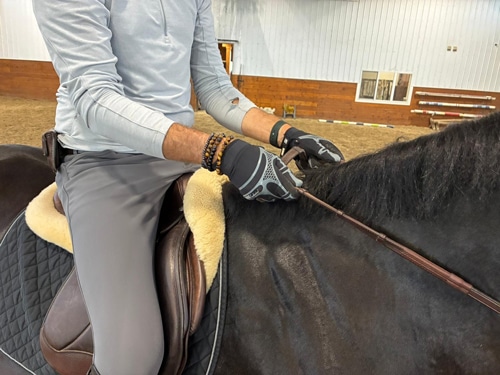
The driving rein. (Holly Grayton photo)
A driving rein is actually just a different way for a rider to hold their reins – the action of the rein can still vary. Trying to ride with a driving rein can be an interesting experiment, and it can be used to correct a few common mistakes such as a stuck elbow, or a rider that relies too heavily on their reins. Often we will ask our students to use a driving rein to understand more freedom in their arm and hope to learn some new muscle memory of how their arm can operate effectively while free. It can be fascinating to watch the transformation, and I would argue it is a good tool for even the most accomplished riders to learn.
The final way to hold your reins is a bridged rein. This is also a different way to hold the reins, where the excess amount of rein behind where the rider is holding the reins is added to the rider’s hands to hold on to as well. This makes for more rein to hold onto, and also essentially ties the rider’s hands together, limiting excessive lateral movement of the hands.
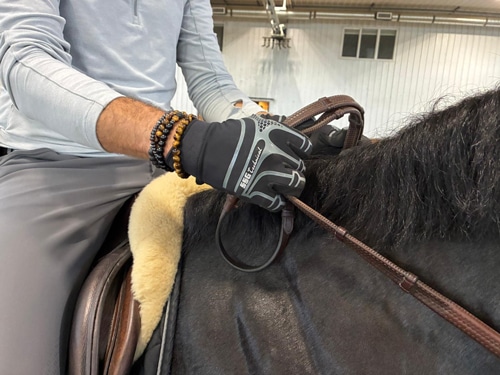
The bridged rein. (Holly Grayton photo)
It shouldn’t go unnoticed that many top competitors use a bridged rein: Kent Farrington, Richard Vogel, and Marcus Ehning are often seen on course using bridged reins. It can help address many problems. If a rider’s reins are simply too long for the length of the horse’s neck, it can be helpful to safely gather up the tail of the long reins. It can also be used for someone that often slips the reins longer and longer as they go around the course, in an effort to change the rider’s awareness of their reins. And I’ve also seen it help with young horses that are rude in their contact and want to go back and forth, left and right, trying to root the reins from the rider. A bridged rein offers the rider and horse stability, connecting the sides together.
As we are all still learning and trying to improve all the time, it’s important for every rider to be acutely aware of what their hands are doing and why. Are they acting of their own accord or are you in charge of what your hands are communicating to your horse? Are you registering the effectiveness of your communication, and is it yielding the desired result? If not, do you have the ability to change your body and habits to experiment with a new method? Are you aware of asymmetries in your horse and yourself that are showing up in how you use or hold your reins and arms differently from side to side?
These important self-reflections are helpful to keep us on our path towards growth and improvement, and more importantly, to help us communicate even better with our horses.
The Latest
